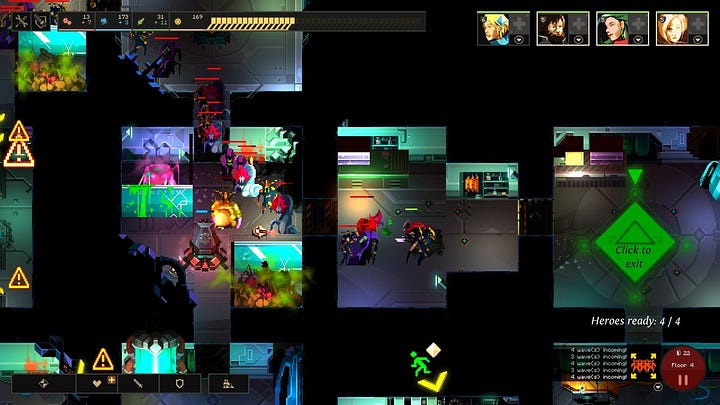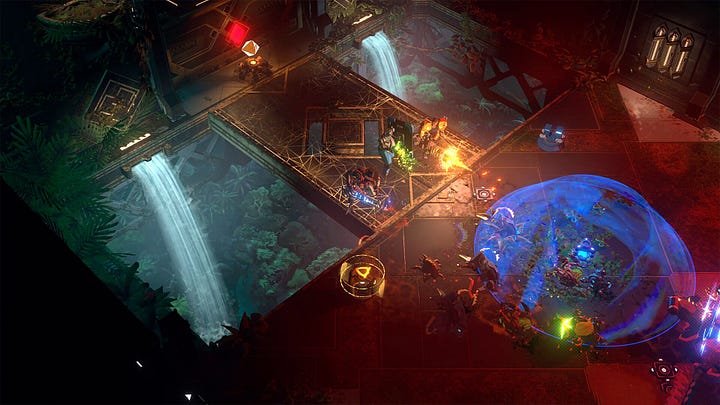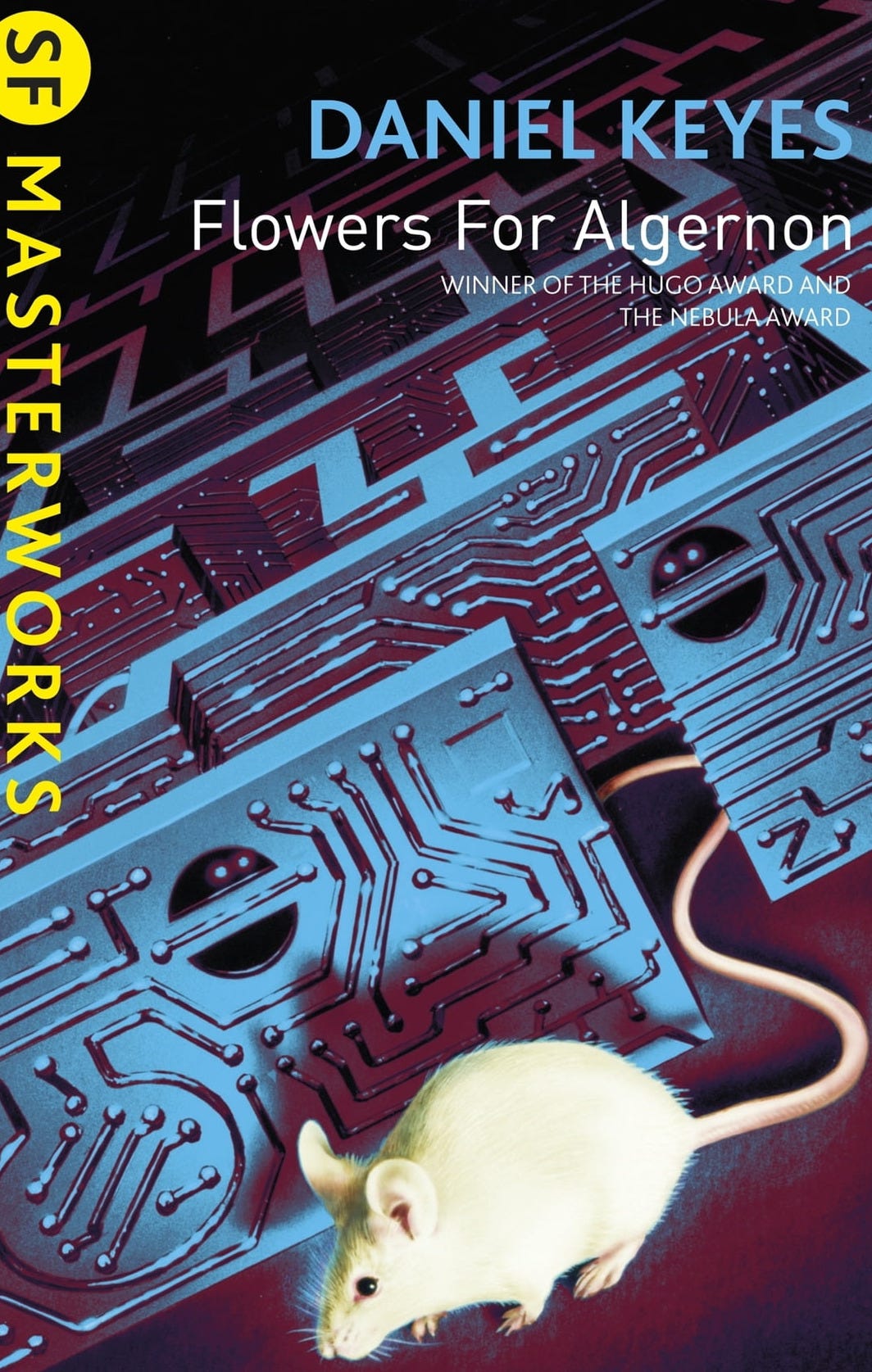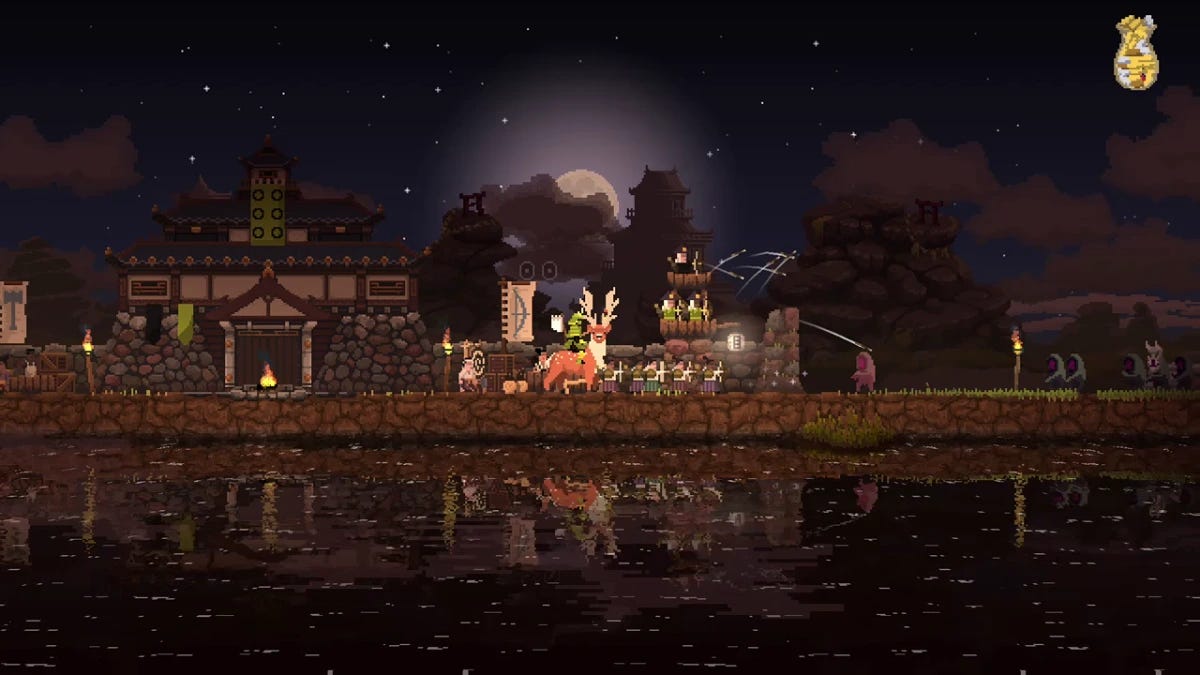Quest Design, Parameter of Procedural Level Design
Big Houses With No Heart(h)s


Computer Science semester 1 being what it is (not to mention my sluggish health and family engagements), I've barely had any time for proper game sessions, not to mention my writing here on game, level & quest design. Hurray for reading week! For this post, I want to think back on two sets of games I've been dabbling in, in the short time periods I've had between lectures, tutorials and assignments: Dungeon of the Endless and its remake Endless Dungeon, as well as Kingdom Two Crowns, which had its free weekend these past few days. I'm rather going to focus on the two Endless games, with Kingdom as a more superficial counterpoint.
Let's first do a call-back to our previous post's "methodological bifold" problem:
1) a belief founded on something outside of the object of the belief itself, which we named "anterior temporality" or "absence of direct contact";
2) the justification of this belief through a posture of "inherent aesthetics" conferring a compensation to the believer for the aforementioned "absence of direct contact".
The Endless Dungeon games propose a type of gameplay based on a hybridization of facets: RPG evolution of heroes; tower-defense-type turret building; procedural generation of rooms. Within these rooms you can maybe find a merchant, items, monsters or the "exit" of the current floor, all the while periodically facing monster waves which attack your resource generators as well as, ultimately, your "Golden Crystal" which you must ferry through the floors to the "final" Exit.
The remade game ditches the moody 2D pixelated and very obscure gameplay parameters (such as incomprehensible hero stats) in favor of a 3D isometric rendition, along with a lot more explicit lore and RPG components. A LOT MORE EXPLICIT. Otherwise, the gameplay is quite similar, albeit with the switch from a "park the Hero in the room" to a "twin-stick shoot while controlling the Hero", with more weapon variety and different types of enemies with various strengths and weaknesses. The reviews are quite mixed for the remake, probably because of its nature as a remake, although in my view it is superior to the original in almost every aspect.
What's really interesting is how, despite Endless Dungeon being a superior game to its predecessor, it gives off the relatively same "vibe" to me: it's as if structurally, despite SOME changes, the main formula is the same; and the end-result is not positive overall.
You see, the original Dungeon had and still has, all these years later, the same problem: it combines (minimalism), (pixel graphics) and (game genre hybridization) in such a way as to render each of these elements to their full weakness, while not developing them enough to counter-balance their shortcomings with a full set of features & complexity to experiment and have fun with. You have to "ascend" 12-13 floors with your 2-4 heroes, which sounds like a mighty cool adventure, that is until...
you get killed by a difficulty spike you did not or could not prepare for;
you do the first 3-4 floors and have a good loop established as to the modules & turrets you build, but each floor is a more-or-less just a copy-pasted repetition of the previous one, and they each last for pretty long, like 10-15 minutes at a time, only with a slightly different room configuration owing to the game's procedural generation;
you realize equipping weapons & items is purely abstract with no changes in term of animations or gameplay except for better chances of surviving monster waves;
except for some dialogue in the elevator between floors, there's no story or quest design to speak of, which when multiplied by 12-13 floors really drives home the repetitiveness of the experience and a certain feeling of emptiness;
random generation further hurts the "play"/experimentation part of the equation because a particular room setup might inevitably lead you to lose your run despite even the best efforts.
By reaching into our methodological bifold problem, we come full circle and manage to express these disparate and somewhat discrete elements into a meaningful whole:
As the novelty wears off and the repetitive nature of the content rapidly sets in, it's as if the game is beckoning us 1) to keep playing in the name of something (discover a new element/hero/room, get to the end, etc.) whose nature and functioning is outside of our direct contact with the content of the game; 2) to enjoy the game for its inherent aesthetics as compensation for an ultimately long and bare-bones experience with undeveloped mechanics.
Mind you, this is all the more striking when you consider that the developers managed BOTH times, in the original AS WELL as the reboot, no matter how different the games are, to recreate the exact same feeling.
You get to a point in a run, often after a few floors, where even if you're doing well, you just can't bring yourself to open that next door, to face that next wave, to build the next turret. You've caught the Endless Dungeon fatigue.
I also believe the methodological bifold can explain the curious finding that most Steam reviews are more negative for the remake than the original, and they often complain about the remake losing that "spice" or "mood" that the original had: these are the people who had convinced themselves of the "inherent aesthetics" of the first game, and who now ignore the major improvements of the remake (better visibility, more active player posture, more varied enemies & turrets, huge improvement to lore and supporting characters, etc.) ultimately because they can't bring themselves (the aesthetics being so different from one game to another) to "transfer" the compensation granted by their dedication to the methodological bifold of the first game.
This leads us to yet again, as in our previous post, consider the implications of the "bifold problem" in the wider discussion of the interplay between quest & level design. Previously, we had first targeted the activity of "Grinding" in games as the entrance point to the theoretical tool of the "bifold", and next we had mentioned how games like Deus Ex and Hitman 3 (we still need to go into detail for Hitman, hopefully I can get to that next time) could mobilize quest design to such an amazing degree that the more or less the same level (Statue of Liberty in Deux Ex) could successfully motivate players IN MULTIPLE WAYS thanks to the marriage of level design complexity with (CRUCIALLY) meaningful, rich and unique (aka non-procedurally generated) quest design which, if changed as change it did during that game, could "render" the same "level" but in radically different forms and with radically different significance for the player.
With the E-Dungeon games, we faced more or less the exact opposite: both games suffer from the same absence of meaningfulness in their quest design. It is especially hurtful (as well as ironic) to say this about the second game, which officially and explicitly institutes lore pieces AS WELL AS QUEST LINES for each of their heroes. But so long as those quests and that lore does not inform the moment-to-moment gameplay, it is all for naught and it's as if there was no quest design to speak of at all.
Today's lesson, then: the levels and mechanics of a game don't just need ANY quest design, and they don't just need MEANINGFUL and UNIQUE (as in not procedurally generated) quest design; for a game to be good, to speak and bring players in true interface with it, it needs (quest design), it needs (GOOD quest design) and that (quest design needs to directly inform and render the moment-to-moment gameplay). In other words, you cannot separate quest from level design; or by separating the two, and putting too much emphasis on level design, you risk building the most elaborate maze no mouse will be truly motivated to run through.
It is just as deceitful to believe a mouse runs through a maze for the reward of the sugar cube/juice at the end, as it is to believe that a human being sits down in front of a game in order to get their dopamine hit: there's an entire layer of psychology, of the unconscious, of the personality and meaning particular to each individual which colors and renders texture to their will and desires. Sure, scientists can correlate the physiological responses and stimuli with which organisms deal with and construct their theories in consequence, but that goes beyond - and misses the point of - the meaning living beings attribute to their own idiosyncratic existence, robs them of their soul by imposing an exogenous explanation of their very animation.
Games and game design are a marvelous opportunity to reverse that momentum: to craft levels, to build mazes, to speak to players "by direct contact", by establishing through the interface between your game and their existence a common, endogenous, ground of negotiation of experimentation, learning, and enjoyment/entertainment.
Before concluding, I haven't much played Kingdown: Two Crowns, but it does feel like that game is a good counterpoint to the E-Dungeons we've discussed here. At first contact, it doesn't seem to have any quest design to speak of; but as you start playing, you build YOUR OWN understanding of how its world works, how its mechanics work and what it all means through the act of experimentation itself. While it also has its repetitive elements and a certain facet of procedural generation, it is much more strongly structured in such a way as to encourage you to explore with the game, but on your own terms and when you feel ready to write the next page in the chapter of your "monarch's" story within the game. To put it briefly, when I think of playing Kingdom again, I wonder what I might do and what that might have as an effect on my "domain"; I think of what I might do to experiment and how those experiments might pan out; I think of the ways I can have fun with it.
And in conclusion, the numbers speak for themselves: SteamCharts shows that the E-Dungeon games barely hit 100 daily average players, while Kingdom Two Crowns, even before the free weekend, was managing an order of magnitude bigger than that, with an average around 1000 players per day (26k during the free weekend). To follow up on this logic, we might ask ourselves if indeed all of the games in the top 10 or top 100 of most played games on Steam have a great marriage of quest and level design: that's a pretty crazy project and one surely worth doing, just for the craziness of it. But consider the current number two game: Banana; a simple game where, every three hours, you are offered to click a banana. Is it so hard to believe the success that a game with very simple quest & level design can achieve WHEN that marriage makes so much sense, when it's so original that so many people get together and a community around that simple and accessible experience forms so spontaneously and, at first view, unexpectedly? Is it so unbelievable to consider that people might coalesce around an experience that makes them socialize so easily and have fun, no matter how "abstractly" dumb it might be considered?
Isn't Banana-game the perfect retort for every dopamine-challenged scientist out there?!
Until next time, then! If you're interested in this kind of discussion of games and game design, consider subscribing and staying up to date with new posts. And by all means, share and comment if you're so inclined.



